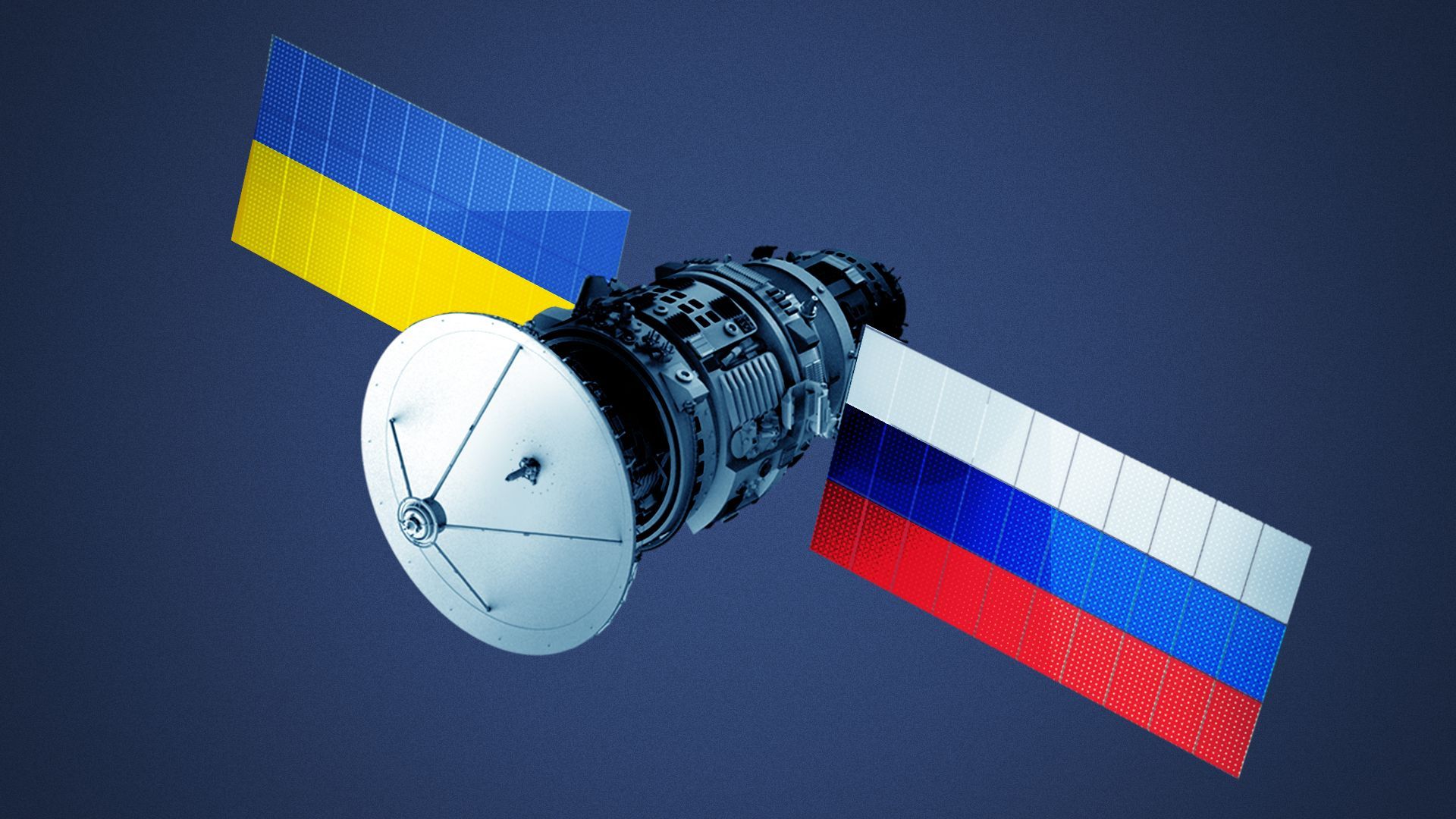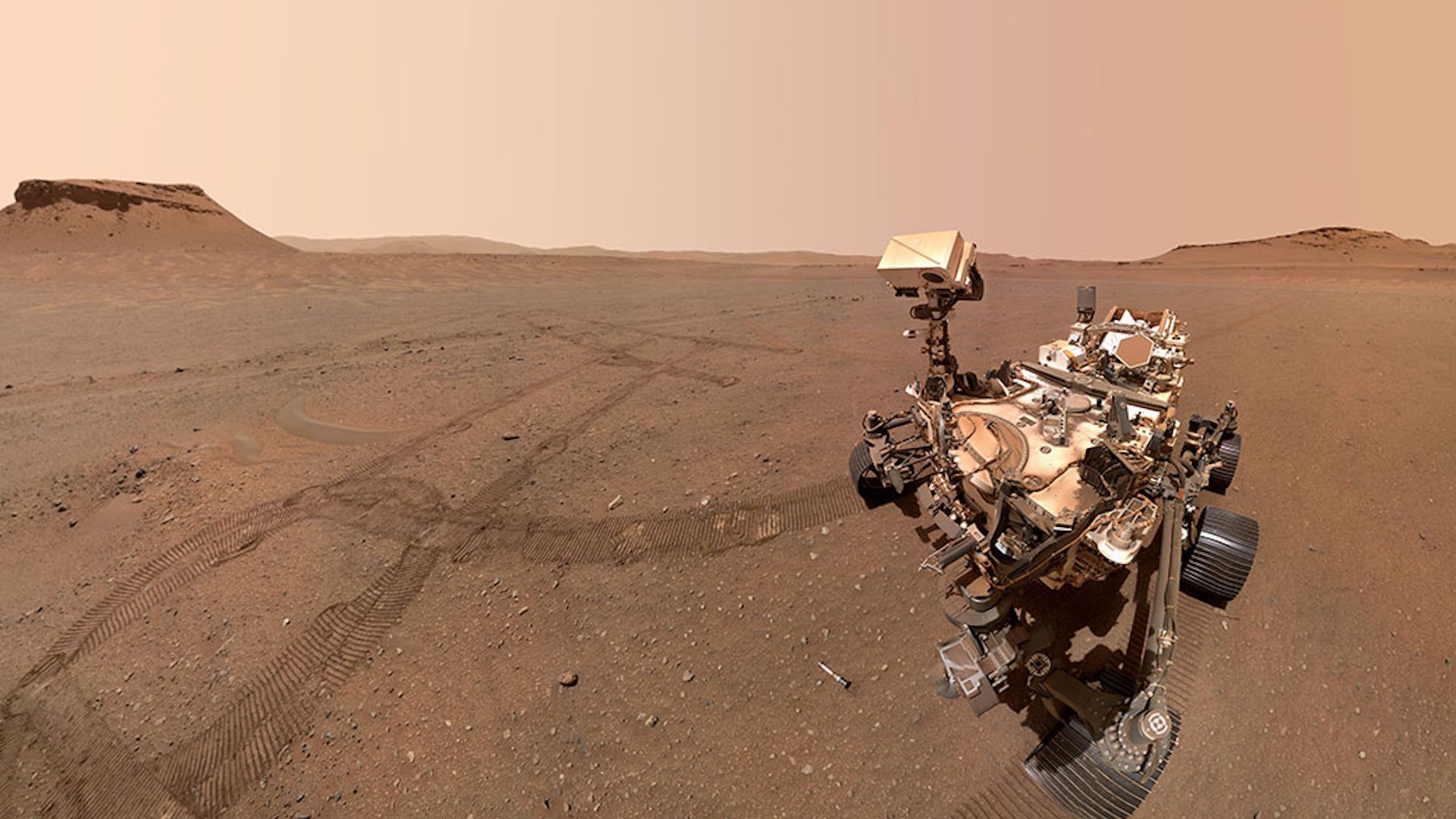| | | | | | | | | | | Axios Space | | By Miriam Kramer · Feb 21, 2023 | | Thanks for reading Axios Space. At 1,221 words, this newsletter is a 4½-minute read. - Please send your tips, questions and satellite data to miriam.kramer@axios.com, or if you received this as an email, just hit reply.
| | | | | | 1 big thing: Space brings transparency to the war in Ukraine |  | | | Illustration: Shoshana Gordon/Axios | | | | Detailed images of the battlefield in Ukraine taken from space and satellite internet beamed to the war's front lines have shaped the year-long conflict — and how the public understands it. Why it matters: Space-based technologies have been essential to warfighting for decades, but their use in the conflict in Ukraine has demonstrated how they can give citizens a clear view of war. What's happening: Planet, Maxar and other companies are using satellite images beamed back from orbit to reveal details of what's happening on the ground. - In April 2022, satellite photos disproved claims by Russia that images of bodies in the streets of Bucha were staged by Ukrainian forces. Photos from Maxar showed bodies in the streets before Russian forces pulled out of the city.
- SpaceX's Starlink has also been key to Ukraine's efforts, allowing people on the ground to access the internet and aiding in situational awareness on the battlefield.
The big picture: In an interview with the BBC last year, the head of the Space Force Gen. Jay Raymond said the war in Ukraine is the "first war where commercial space capabilities have really played a significant role." - Many of these companies are also regularly sending these types of photos to media outlets.
- "[T]he worldwide attention to the event has been much larger, much wider, and our imagery has been used to help tell a critical story going on at this point," Maxar CEO Dan Jablonsky tells Axios.
- Through the release of images of the war in Ukraine, both Maxar and Planet say they aim to increase transparency and accountability.
- "As the saying goes, 'Sunlight is the best disinfectant for democracies,' and we feel that advances in commercial imagery are helping to provide that sunlight and shepherd in a new era of shared awareness at a scale that we really haven't seen before in past conflicts," Planet Federal's Robert Cardillo tells Axios.
Between the lines: These companies could also be putting their assets at risk through their efforts. - SpaceX's Elon Musk said in May 2022 that Russia's cyberattacks on Starlink have ramped up.
- A Russian official said in October that commercial satellites could be considered "legitimate" targets for retaliation.
The intrigue: Using commercial assets in wartime also allows private companies to make decisions about what's acceptable use and what isn't. - SpaceX this month limited Starlink capabilities in Ukraine after the nation's military used the satellite constellation to operate drones targeting Russian troops.
- Starlink "was never intended to be weaponized, but the Ukrainians have leveraged it in ways that were unintentional and not part of any agreement," SpaceX president and COO Gwynne Shotwell said on Feb. 9.
What to watch: These uses of space technology could have far-reaching consequences in the future. - Planet and Microsoft collaborated to create a building damage assessment tool for Ukraine. "This is something that normally would have taken months to complete, but given the urgency, was delivered in a matter of weeks," Cardillo said.
- Government agencies have already been partnering with these companies to buy imagery for years, but the uses of the data during the war in Ukraine could further entrench those partnerships.
|     | | | | | | 2. SpaceX to launch new crew to ISS |  | | | A Falcon 9 rocket launch in October 2022. Photo: SpaceX | | | | SpaceX is set to launch four new crew members to the International Space Station on Sunday. Why it matters: The mission marks SpaceX's seventh crewed trip to the space station for NASA, further cementing the company as one of the space agency's most important partners. Details: The Falcon 9 rocket carrying a Crew Dragon is set to lift off from Cape Canaveral, Florida, at 2:07am ET Sunday. - The spacecraft is expected to deliver NASA astronauts Stephen Bowen and Warren Hoburg, and United Arab Emirates astronaut Sultan Al Neyadi, plus Russian cosmonaut Andrey Fedyaev to the ISS.
- This will be the first spaceflight for Hoburg, Al Neyadi and Fedyaev, and it will mark Bowen's fourth spaceflight.
- The crew is expected to spend about six months on the space station performing maintenance and conducting science experiments.
The big picture: The mission comes during a busy time on the ISS. - Russia is expected to launch a replacement Soyuz spacecraft on Feb. 23 for a crew of three already on the station after their original craft unexpectedly leaked coolant, making it potentially dangerous for people to fly.
- Another Russian vehicle, a cargo ship, undocked from the station on Feb. 17 and was inspected after it also leaked coolant.
- There are currently seven crew members on the station.
What's next: Boeing is expected to fly its first crewed mission to the ISS in April. - The company has faced a series of technical setbacks and delays, but Boeing and NASA said last week that the company's preparations for flight are going well and they're moving ahead toward a launch in mid or late April.
|     | | | | | | 3. An anniversary on Mars |  | | | Perseverance on Mars. Photo: NASA/JPL-Caltech/MSSS | | | | NASA's Perseverance is rolling into its third year on Mars, continuing its search for interesting rocks that might hold signs of past life on the Red Planet. Why it matters: Previous missions have found that at least parts of Mars were once habitable for microbes, but Perseverance is charged with finding any possible signs the world was actually inhabited. Driving the news: Perseverance hit two years on Mars on Feb. 18, just after completing a depot containing 10 samples of the Red Planet that will serve as a backup for a future sample return mission. - In the rover's two years on Mars, Perseverance (nicknamed Percy) found not just sedimentary rock in its landing area — Jezero Crater — but also igneous rock, which will help scientists figure out when the planet changed from the relatively warm, wet place it once was to the dry desert we see today.
- "Perseverance has inspected and performed data collection on hundreds of intriguing geologic features, collected 15 rock cores, and created the first sample depot on another world," Perseverance project scientist Ken Farley said in a statement.
The big picture: Instead of primarily focusing on learning more about Mars from its surface, however, Percy is built with future science in mind. - The samples it's collecting on Mars are expected to be collected and delivered back to Earth for waiting scientists to analyze using powerful tools that will hopefully reveal whether the planet once supported life.
- So far, Perseverance has filled 18 out of 38 sample tubes available — 15 with rock, two with regolith and one with air from the Martian atmosphere.
|     | | | | | | A message from Axios | | Subscribe to Axios Daily Essentials | | |  | | | | Axios Daily Essentials keeps you up to speed on the topics shaping our lives in politics, tech, business, media, science and the world. Delivered every morning, afternoon and evening. Subscribe for free | | | | | | 4. Out of this world reading list |  | | | Illustration: Aïda Amer/Axios | | | | 🧂 New type of salty ice may exist on extraterrestrial ocean moons (Ashley Strickland, CNN) ☄️ New space radar will hunt planet-threatening asteroids (Briley Lewis, Scientific American) 🪖 Space Force considers public-private partnerships to respond to crises (Sandra Erwin, SpaceNews) 🚀 The FAA moves to fine SpaceX $175,000 (Axios) |     | | | | | | 5. Weekly dose of awe: Nearby galaxies in view |  | | | Photo: NASA/ESA/CSA/J. Lee (NOIRLab)/A. Pagan (STScI) | | | | The spiral galaxy NGC 1433 swirls in this new photo taken by the James Webb Space Telescope. - Scientists are using the telescope to take a look at the structure of and star formation within this galaxy and others like it.
- "Areas which are completely dark in Hubble imaging light up in exquisite detail in these new infrared images, allowing us to study how the dust in the interstellar medium has absorbed the light from forming stars and emitted it back out in the infrared, illuminating an intricate network of gas and dust," Karin Sandstrom of the University of California, San Diego, who has been using JWST to study these types of galaxies, said in a statement.
|     | | | | | | A message from Axios | | Subscribe to Axios Daily Essentials | | |  | | | | Axios Daily Essentials keeps you up to speed on the topics shaping our lives in politics, tech, business, media, science and the world. Delivered every morning, afternoon and evening. Subscribe for free | | | | 🛰 Big thanks to Alison Snyder for editing, Sheryl Miller for copy editing, and Shoshana Gordon and Aïda Amer for the illustrations. If this newsletter was forwarded to you, subscribe. |  | | Are you a fan of this email format? Your essential communications — to staff, clients and other stakeholders — can have the same style. Axios HQ, a powerful platform, will help you do it. | | | | | | Axios thanks our partners for supporting our newsletters.
Sponsorship has no influence on editorial content. Axios, 3100 Clarendon Blvd, Arlington VA 22201 | | | You received this email because you signed up for newsletters from Axios.
To stop receiving this newsletter, unsubscribe or manage your email preferences. | | | Was this email forwarded to you?
Sign up now to get Axios in your inbox. | | | | Follow Axios on social media:    | | | | | |
No comments